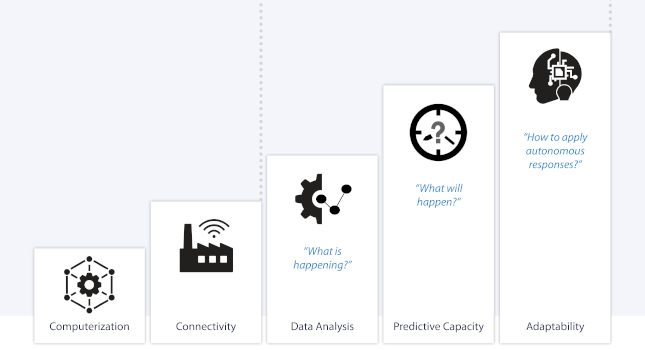Exploit IIoT to improve operations
Off-the-shelf IIoT solutions use intelligent routers and associated cloud services
A race is underway to find the best ways to extract factory data and connect it with cloud computing services. The finish line may be a little hard to discern, but end users and OEMs alike want to collect this data, and then use third-party apps or their own self-developed analytics to gain value by improving their operations.
Connecting all sorts of operations technology (OT) systems up to on-site and cloud-based information technology (IT) resources is the foundation of industrial internet of things (IIoT) and Industry 4.0 projects. These connections are also necessary for performing data logging, product tracking, analytics and visualization. While some new field-located equipment will arrive with native cloud connectivity, most users will have many legacy systems they would like to tap into for data access.
However, stitching together a complete field-to-cloud data connectivity solution is not a good option for most applications. It is complex to determine the best hardware, software and networking elements to deliver reliable and secure performance. Instead, these users need a dependable off-the-shelf solution so they can focus on the field and cloud endpoints.
This article discusses what users should look for when selecting a cloud platform to support their IIoT projects.
An IIoT maturity model
Industrial manufacturing operations need data to fully take stock of their equipment assets, raw materials, output and production efficiencies. There is a lot of different data originating from a variety of sources, and it can be difficult to know where to start. An IIoT maturity model can help users understand their current state and where they can make improvements (see Figure 1).

Figure 1: This IIoT maturity model depicts how companies progressively digitalize their operations, in order to more effectively access and act on operational data. Courtesy: Automation Direct
Many companies are well under way with using programmable logic controllers (PLCs) and PCs to perform local automation and computerization of their equipment and systems. They may also have established good network connectivity on-site.
But the next steps into Industry 4.0 call for connecting source data to more elaborate — and typically cloud-based — resources for analyzing, predicting and adapting operations. At the very least users will want capable visualization of their operations, but they will quickly find it important to develop their own cloud-based analytics and learning systems in a way that carefully protects their intellectual property.
Some users might build their own computing solutions from the ground up, but most are far more likely to integrate with and leverage widely used systems like:
- Microsoft Power BI and Azure
- Tableau business intelligence and analytics platform
- Ultimo asset management.
End users and OEMs are more interested in getting to the valuable end results of data storage and analysis than they are in building a solution to transport this data. This is why they need a flexible and secure data handling solution which can be set up quickly and maintained easily.
IIoT connectivity essentials
There are many connectivity, security and reliability requirements for an IIoT data connectivity solution. Among the most important is an open platform without a vendor lock to provide the most flexibility moving forward. Other key requirements are:
- Intelligent routers for connecting to many PLCs and human-machine interfaces (HMI)
- Support for the most common OT communication protocols
- Simplified cloud logging (real-time and historical) for PLC data sources
- Multiple IT integration methods, such as an API and web hooks
- Flexible licensing and management services
- Comprehensive security support, certified to ISO 27001
- Connection reliability
- Connectivity.
A primary goal is to convey data into the cloud, while a secondary need is making that data accessible to the users and applications that need it.
Remote connectivity and monitoring solutions for industrial IIoT projects must include hardware and software elements to connect with all OT data at a site and transport it to the cloud. One of the best architectures for this involves an intelligent router on site, connected seamlessly to a cloud platform via the internet (see Figure 2).

Figure 2: An AutomationDirect StrideLinx router can seamlessly connect with PLCs and HMIs on-site, providing a cloud-capable remote connectivity and monitoring solution. Courtesy: AutomationDirect
Not only must the router support all standard OT communication protocols, but users should be able to configure and download router settings from the cloud without visiting the site or adjusting the target PLC programs. A connectivity solution of this type can be added to any installation without impacting the underlying and existing automation systems, and it can be optimized for logging both real-time and historical data to the cloud (see Figure 3).

Figure 3: AutomationDirect StrideLinx VPN routers are optimized to work on-site and accessPLC data, and then transmit it efficiently and securely over the internet to the StrideLinx cloud platform. Courtesy: AutomationDirect
Access to this data can be accomplished in many ways. A mobile app will provide basic data visibility to any authorized users. Web hooks can tie to external applications to provide more advanced functionality, such as generating text/email alarms upon problem conditions so service teams can respond rapidly. The most capable method is usually an application programming interface (API) as it enables cloud computing services to dynamically access any data needed from the cloud database.
Licensing associated with any cloud solution should be flexible, simple and affordable. Users need the capability to easily add and remove tags without getting bogged down with complex tag-count schemes or other issues. From a system management standpoint, cloud solutions should incorporate centralized monitoring and logging to detect performance anomalies.
Security
A natural concern when implementing any data access project surrounds its cybersecurity aspects. This is a complex subject, which requires specialized expertise and significant IT know-how if a user is building their own custom solution. The best way to address security is to select an off-the-shelf solution that uses coordinated routers and cloud services certified to ISO 27001 requirements. Routers should incorporate firewalls, reject outside traffic, use secure protocols over outgoing ports, provide comprehensive user access restrictions and include two-factor authentication. Third-party scanning and auditing should be employed on a continual basis by the hosted VPN service provider to detect any vulnerabilities in the network.
Reliability
Reliability is created by removing single points of failure. Routers should be capable of failing-over from a primary/preferred network to a secondary/fallback network, whether the connection is Wi-Fi, 4G, or Ethernet. If a connection is lost, the router must include significant on-board memory to log data until the connection is back online and the data can be transmitted. Cloud services should be networked throughout dozens of servers at geographically diverse data centers worldwide to provide responsive operation and redundant storage and processing.
Real-world applications
Once an end user or OEM has chosen an IIoT connectivity solution addressing the details indicated above, how might they use it?
A majority of users are relying on these solutions strictly for the data handling capability, while a growing number are also incorporating visualization capabilities to effectively create a remote/mobile HMI experience.
Many users are OEMs who deploy machines to many locations and need a consistent way to access them, while carefully segregating clients from each other. Increasingly, end users—or their designated systems integrators (SIs)—are rolling out IIoT projects using cloud solutions.
OEM access
OEMs are not only interested in the performance and throughput of machines on a case-by-case basis. Many find it extremely valuable to consolidate data from a fleet of deployed equipment, so they can perform deeper analysis, leading to better ways of optimizing operation or avoiding problems. This can include condition monitoring data like equipment temperature and vibration. Some cloud IIoT solutions can be ‘white labelled,’ so the OEM can offer these hardware and software services as a value-added feature with their own branding.
End user analysis
End users can employ a cloud IIoT solution that is scalable from one machine, up to an entire site or across many sites, to gather the data they need in a consistent manner. As with OEMs, sometimes this production, availability and energy usage data is needed for more advanced operational analysis. In other cases, end users need to track usage of raw materials through the production process, monitor on-site inventories of products or perform other tasks.
IIoT solutions simplify
Creating a field-to-cloud IIoT solution from scratch is not feasible for most end users and OEMs because it requires detailed implementation and support for the required connectivity, security and reliability. Off-the-shelf solutions are available to address each of these aspects, making it easy to add IIoT capability to any existing on-site system, and to connect these systems to cloud resources for advanced processing. An end-to-end solution using intelligent routers and associated cloud services helps users of all types quickly establish a trustworthy IIoT system so they can begin realizing value and improve their operations.
Do you have experience and expertise with the topics mentioned in this content? You should consider contributing to our CFE Media editorial team and getting the recognition you and your company deserve. Click here to start this process.





